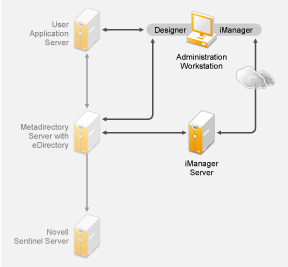3.1 Management Tools Guidelines
The two main management tools for the Identity Manager solution are Designer and iManager, as illustrated in Figure 3-2. Designer is used during the planning and creation of the Identity Manager solution, and iManager is used for daily management tasks of the Identity Manager solution.
Figure 3-2 Identity Manager Management Tools

This document contains information only about Designer and iManager. The User Application uses a Web-based administration page that is not discussed here. For more information about the User Application, see “Administering the User Application” in the User Application Administration Guide.
3.1.1 Designer Guidelines
Designer is a thick client that is installed on a workstation. Designer is used to design, test, document, and then deploy your Identity Manager solution. Using Designer throughout the planning phase helps you capture information in one place. It also helps you see issues you might not be aware of as you look at all of the components of the solution together.
There are no major considerations for using Designer, unless you have multiple people working on the same project. Designer allows for version control of the project. For more information, see Version Control
in Designer 3.5 for Identity Manager 3.6 Administration Guide.
3.1.2 iManager Guidelines
iManager is the administration tool for Identity Manager. When you install Identity Manager, the installation expects that you already have an iManager server installed in your eDirectory tree.
If you have more than 10 administrators constantly working in iManager at one time, you should have a server that hosts only iManager. Figure 3-2 represents this configuration of your Identity Manager solution. If you have only one administrator, you can run iManager on your Metadirectory server without complications.